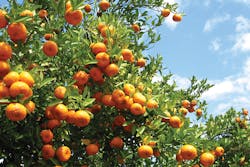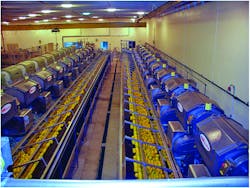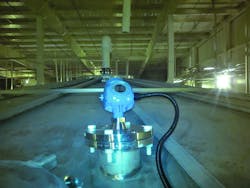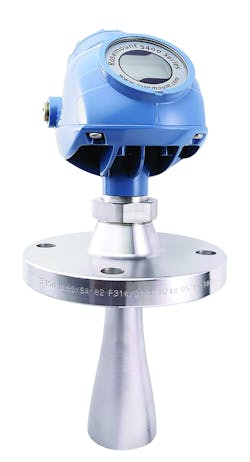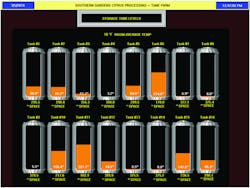Radar level measurement improves inventory control for citrus processor
Growing citrus has many challenges, as does processing the fruit. Nonetheless, in the state of Florida, it’s a $9 billion industry with 600,000 acres dedicated to citrus groves supporting about 74 million trees. Altogether, 76,000 people in the state are engaged in all phases of citrus production.
This population includes Southern Gardens Citrus, a grower/processor based in Clewiston, Florida. Southern Gardens Citrus is a worldwide supplier of premium, not-from-concentrate (NFC) Florida orange juice as well as orange by-products. The Southern Gardens Citrus processing plant was built in 1994 and is capable of processing up to 180 million pounds of oranges a year. The facility can store 56 million gallons aseptically, and ship and receive more than 100,000 tankers annually.
Like others in this industry segment, Southern Gardens Citrus must deal with problems such as citrus greening disease, international competition, and the inefficiencies that come with an aging plant, while staying as profitable as possible. Its facility in Clewiston — while still the newest of its kind in Florida — is 25 years old.
Figure 1. Extracting juice is fully automated and the lines run continuously. Image courtesy of Southern Gardens Citrus.
Juice and more
Oranges and grapefruit are far more versatile fruits than most people realize. Juice is the primary product, but little of the whole fruit goes to waste. Once the juice is extracted (Figure 1), the peels are squeezed to produce a liquor, which can be made into citrus molasses for use in distilleries and even as cleaning products. The solids from the peel and pulp can also be dried, pelletized and sold as cattle feed. This article will focus on making orange juice concentrate.
To produce concentrate, fresh juice is put into an evaporator, where much of the water is removed until the specific gravity is raised to 65 °Brix, so it is very viscous. Storing the concentrate takes place in a special building within the facility where 16 tanks stand close together connected by catwalks (Figure 2). Each tank is 32 feet in diameter by 32 feet tall with a capacity of 186,514 gallons.
The building is a huge freezer. Florida is known for its heat and humidity, but the temperature inside this building is a frigid 16 °F (-9 °C), with a lot of internal air movement. Maintaining this environment allows the product to cool rapidly in the tanks, with no internal cooling coils or jackets required. And even with a product this viscous, foam can be created, so the product movement has to be handled carefully, with all filling and emptying processes from the bottom.
The tanks cycle through filling and emptying cycles one-by-one so there is activity in the freezer room on a daily basis. This is where all the concentrate inventory is stored, so it has to be monitored carefully to determine how much product is in each tank.
Figure 2. Operators can walk around the freezer building above the tanks on a network of catwalks, but it is close to the air handling equipment and very cold. Image courtesy of Southern Gardens Citrus.
Monitoring concentrate inventory
When first built, Southern Gardens Citrus’ tanks were fitted with ultrasonic acoustic level instruments designed to determine the level in each tank reading from mounts on the tank roofs. These instruments proved to be temperamental and were removed from service. Operators had to check the tank levels on a daily basis by hand, using manual measuring devices. While the idea of going inside a freezer on a hot day in south Florida might have some appeal, the novelty wears off quickly when it takes up to 30 minutes to check just one tank while working in the bone-chilling temperatures.
Parkas and gloves are the uniform, and none of the operators necessarily like getting tasked with the job. It is also clear that checking 16 tanks daily required eight hours, so the plant spent as much as 56 man-hours per week on nothing but checking inventory in these concentrate tanks. Considering that plant operators are in short supply nationwide, telling a prospective employee that he or she will spend many hours in a freezer makes the job even more challenging to attract and retain operators.
Figure 3. The new radar instrument bolted in place using the existing flanged spuds. Image courtesy of Southern Gardens Citrus.
Southern Gardens Citrus is a highly automated plant, so the notion of having to perform this routine level measurement task manually every day seemed a wasteful misuse of human resources. Unfortunately, the negative experience with the earlier measurement technology left an impression that meant any new solution would have to prove itself capable of solving several critical challenges including:
- Deliver continuous readings that are precise enough at all product levels to satisfy production and financial planners
- Perform flawlessly in the constant low-temperature environment of the freezer building
- See through any layer of foam to determine the true product level
- Eliminate any reason for operators to enter the freezer building related to level measurement
Figure 4. The Rosemount 5402 is a two-wire, non-contact radar level instrument. Courtesy of Emerson Automation Solutions
Finding the solution
After studying Southern Gardens Citrus’ application, Emerson engineers suggested the Rosemount 5402 Non-Contact Radar Level Instrument (Figure 3). On paper it had the right specifications for measurement precision and maximum distance, and the electronic elements were rated for temperatures down to -40 °F (-40 °C). It could even be mounted using the flanged spuds on top of the tanks originally designed for the earlier ultrasonic instruments, so no tank modifications would be necessary. But, one question would have to be answered: Would it work as well in real life as the specs promised?
The first question related to foam. The concentrate coming out of the evaporators is viscous, but still flows easily prior to cooling. It is also prone to foaming. As a result, all connections to the concentrate tanks are from the bottom to eliminate any splashing. Still, there can be a layer of foam on top that forms during filling and tends to freeze. The foam surface is capable of reflecting the radar pulse, causing the instrument to deliver a false reading.
However, if the pulse is strong enough, the actual liquid surface can send a second reflection, and the measuring software can capture it as the true reading. The suggested non-contact radar level measurement instrument uses an approach called dual-port technology, which creates a stronger radar pulse for just this type of multiple echo application. This can be a much better approach for these and other similar applications than single-port configurations where the pulse is sent out and returns through the same port. This causes some of the energy to be diverted in both directions and results in lower usable power for the reading.
With dual-port technology, the pulse leaves through one port and returns through another, so far-less energy is lost. The result can be a 75% increase in reading power compared to conventional designs. This improves the quality of readings where there is potential for multiple echoes from multiple levels, and the one on top is not necessarily the most important.
Although Southern Gardens Citrus had challenges with measuring tank levels, other aspects of the application were favorable:
- The tanks have no agitators, cooling coils or other internal obstructions
- The inlet and outlet are on the bottom, so no product is pumped in from the side or top, which could disrupt the reading
- The instrument is in a good location
- The liquid surface, despite the product’s viscosity, settles flat so there are no mountains or gullies to confuse the radar image
- Testing the concept
The plant made an initial test installation on one tank and found the instrument had no problem with the temperature. That was good news, considering how cable from the instrument’s transmitter runs to a controller located outside the freezer room, and since it is a two-wire device, it carries both the signal and power.
Figure 5. Using Emerson’s Radar-Master software, workers can easily see how much concentrate is in each tank. Courtesy of Southern Gardens Citrus
The unit is also configurable via HART, so once the instrument was bolted in place (Figure 3) in the freezer room, it was possible to handle the settings and adjustments from outside using a handheld communicator, and to check diagnostic information to assess the instrument’s operational status.
The initial success provided all the proof necessary to issue the order to outfit all 16 concentrate tanks, and now data from all the new instruments is captured, presented and analyzed using Emerson’s Radar-Master (Figure 5) software. Southern Gardens Citrus has realized several important benefits, including how:
- Operators can see exactly what is in each tank as they move product in and out of storage
- Planners and accountants have a continuous live picture of concentrate inventory available at any time, not just once each day
- Operators are freed from a cold and tedious task for more important duties
- Plant managers can control output and
- profitability on this important product stream thanks to high-confidence production data
Best of all for the operators, the new solutions mean no more gloves and parka-laden trips into the freezer to take inventory measurements.
Looking ahead, Southern Gardens Citrus hopes to duplicate this success on other troublesome applications in the facility. For instance, working with solid materials such as quicklime in Florida’s heat and humidity can present a variety of challenges. Quicklime is used as part of the cattle feed manufacturing process to reduce the acidity of the pressed peels and dried pulp. One of the company’s targets is finding a better way to monitor quicklime inventory and consumption.
Joe McDaniel has been the controls engineer at Southern Gardens Citrus for 11 years, part of a career in the citrus industry spanning 29 years. In his role he is responsible for the design and implementation of all automation controls at the Clewiston facility.
Don Parry is a senior sales representative for Emerson Automation Solutions with more than 30 years of process industry technical sales experience with customers in power, food and beverage, chemical, pulp and paper, defense and aerospace industries. His current assignment is with Emerson’s Rosemount measurement products covering accounts in Florida and the Bahamas.
